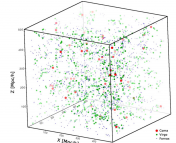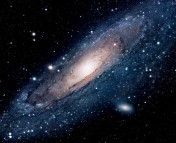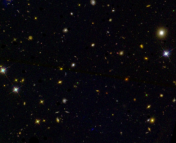Title: Emergence of an Ultra-Red, Ultra-Massive Galaxy Cluster Core at z = 4
Authors: Arianna S. Long, Asantha Cooray, Jingzhe Ma, Caitlin M. Casey, Julie L Wardlow, Hooshang Nayyeri, R. J. Ivison, Duncan Farrah, and Helmut Dannerbauer
First author’s institution: Department of Physics and Astronomy, University of California, Irvine, USA
Status: Submitted to The Astrophysical Journal, open access on arXiv
Galaxy clusters are vast entities. They contain 100 to 1000 galaxies, making them the largest gravitationally stable structures in the cosmos. One of the assumptions of our understanding of the Universe is structures form hierarchically—smaller gravitational objects form first followed by the largest. Therefore, to form large objects like clusters, smaller objects such as galaxies need to collide and merge together over a long period of time.
Although we generally know how clusters form, the specific process by which they grow is not yet well understood. The progenitors of clusters, known as protoclusters, are typically found at redshifts greater than 2 (the higher the redshift, the farther back it is in time), when the Universe was about one third of its current size. Unlike the clusters we observe today, protoclusters do not appear to have an established population of “red and dead” elliptical galaxies, which makes them harder to identify. Instead, protoclusters are usually identified by overdensities of star forming galaxies known as Lyman-alpha emitters, which are typically studied using data in the optical and ultraviolet (UV) wavelength ranges. You can check out other Astrobites on the intriguing properties of protoclusters here, here and here.
The hunt for protoclusters
Today’s paper offers an alternative method for identifying protoclusters via a certain galaxy population known as dusty star forming galaxies (DSFGs). These galaxies contain substantial amounts of dust, which obscures their optical/UV light, but allows them to glow in infrared (IR). DSFGs are capable of forming stars in a short period of time at higher redshifts, which allows them to become the large red elliptical galaxies we see in clusters later on. DSFGS are also typically found in the vicinity of other DSFGS, which suggests they are pivotal to protocluster evolution.
Although protoclusters with DSFGs have been observed before, these have almost all been at redshifts below 3. Above this, a handful of protoclusters have been found but studies are considerably more limited in resolution and the ability to spectrally classify such galaxies.
The authors of today’s paper present insights into the gas, dust and stellar properties within a distant (z = 4!) protocluster containing 11 tightly bound DSFGs, known as the Distant Red Core (DRC). For the first time, this system has new high resolution HST (optical) and Spitzer (IR) observations, bolstered with existing ALMA (submillimetre), Gemini (NIR) and Herschel (FIR-submillimetre) data.
Different components of the protoclusters are shown in Figure 1 using the Spitzer, Gemini and HST data. Combining multiwavelength data is crucial to ensuring that the DRC and potential other members comprise a genuine physical system, and to bypass issues where two or more galaxies appear as one in an image due to blending effects. Within some of these, we can see evidence of merging (e.g. in the long elliptical structure of DC8). The authors note that although there are 11 in total, only 10 are spectroscopically confirmed to be at z = 4 (all except DRC 5).
Outstanding in the field?
Each of the galaxies in the DRC have approximately similar masses (> 1010 solar masses). Interestingly, they exhibit minimal differences in star formation rate and mass when compared with other galaxies at z ~ 4 that aren’t in clusters (known as the ‘field’). The authors demonstrate that the DRC members fit neatly within 1 standard deviation of the measured main sequence (MS) relation at z = 4 (shown in Figure 2). Previous studies have also expected to find more gas in galaxies in cluster environments compared to field galaxies, but the results do not confirm this.
Weighing it up
Finally, the authors infer the total mass of the protocluster. This is difficult as it includes not just the individual stars in galaxies, but the underlying dark matter distribution encompassed within the cluster halo. As we cannot see dark matter, some assumptions are required to determine the total mass. Fortunately, a well-known relationship exists between the stellar and total mass of galaxies, assuming stars in galaxies accurately trace the dark matter content. By summing the masses of the individual galaxy halos, and correcting to avoid double counting halos which overlap, the protocluster mass can be computed. As shown in Figure 3, the DRC is already at least as massive as protoclusters between redshift 2 and 3. Based on this data, the DRC is on course to evolve to above 1015 solar masses by the present day, which would make it one of the largest clusters in our cosmos.
Our current model of hierarchical structure formation allows us to predict the maximum possible mass of protoclusters at various times. The authors show the DRC is large enough that it is on the boundary of being excluded by our accepted cosmological model. Further observations of the DRC will be able to tell us whether such a massive protocluster really is causing a problem (it wouldn’t be the first time). The emergence of the DRC at z = 4 shines a new light on early cluster formation, while also leaving room for many exciting questions that will hopefully be answered in future protocluster studies.




